Dubai 2040: Shaping the Future of a Global Metropolis
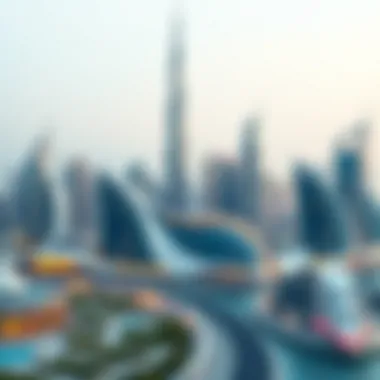
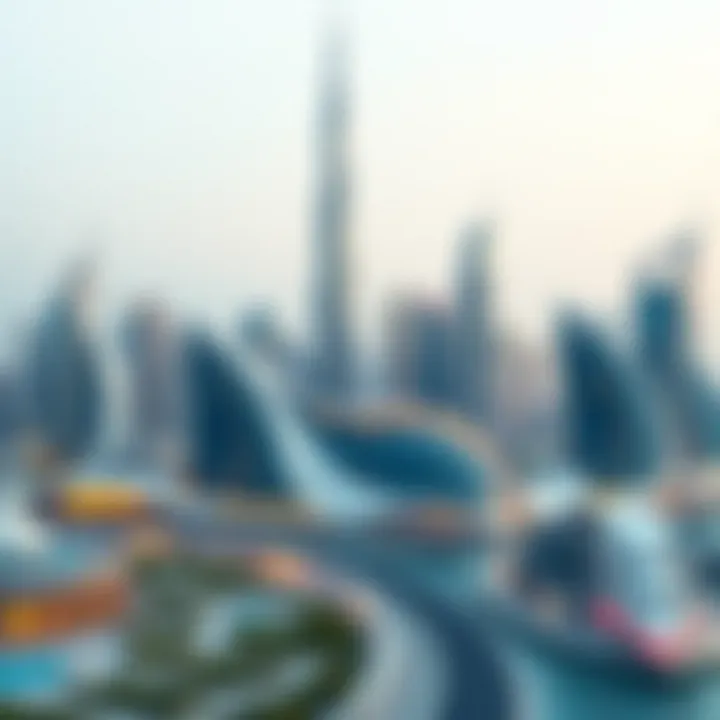
Intro
As Dubai moves forward into the future, the urban landscape is set to undergo significant transformation by 2040. The city, known for its stunning skyline, luxury shopping, and vibrant culture, is working on a strategic plan to position itself as a leading global metropolis. Understanding this evolving environment is crucial for potential investors, residents, and anyone keeping an eye on urban development trends. This article explores various facets of Dubai's ambitious vision, delving into urban planning, advancements in infrastructure, and the integration of lifestyles intended to create a sustainable and inclusive community.
Market Insights
Current Trends in Dubai Real Estate
Analyzing the real estate sector in Dubai gives insight into the dynamics shaping the future. Presently, we observe a steady uptick in demand for urban properties, particularly those emphasizing sustainable living features. Buyers are increasingly prioritizing eco-friendly homes, spurred by global efforts to address climate change. Properties in areas like Dubai Marina and Downtown Dubai remain top choices, fueled by their exceptional amenities and proximity to key attractions.
Beyond demand, the market is displaying notable adaptability. Developers are keenly attuned to evolving consumer preferences, introducing smart home technologies and integrated community facilities. This shift is evident in new project launches that focus on mixed-use developments incorporating residential units, retail spaces, and green parks.
Investment Hotspots and Opportunities
For investors, trailing behind the obvious choices, there are unique opportunities to explore. Areas like Dubai South and Dubai Creek Harbour are emerging as promising investment hotspots. Dubai South, close to the Expo 2020 site, is being rapidly developed and is projected for substantial growth.
In addition, neighborhoods undergoing regeneration, such as Jumeirah Village Circle, present attractive options for long-term investment. The increasing influx of expatriates and entrepreneurs into these areas signals a demand surge that surpasses many established parts of the city.
"The future of Dubai's real estate is intertwined with sustainable and innovative solutions — a vision that appeals to those looking to invest wisely."
Lifestyle Integration
Community Living in Dubai
The pursuit of a more community-centric way of life is evident in Dubai’s plans for 2040. The city aims to enhance social connectivity, thereby fostering a sense of belonging among residents. Community-centric designs are becoming integral, with planned neighborhoods to include comprehensive amenities and shared spaces that encourage interaction. These development plans focus on keeping social interactions vibrant while also promoting a healthier lifestyle through walkable areas and green spaces.
Amenities and Luxury Features
As lifestyles evolve, so do expectations regarding amenities. Dubai's future urban designs are set to incorporate experience-driven facilities, which rarely can be found elsewhere. Whether it’s rooftop gardens, multiple pools, or dedicated wellness zones, luxury in Dubai appears to lean towards integration rather than isolation. Furthermore, smart city technologies will play a crucial role in enhancing daily living, simplifying everything from household management to accessing city services right from a mobile device.
Thus, the developments aiming for 2040 will not only upgrade the urban fabric but also enrich the way residents experience their city. This holistic approach can attract diverse demographics and ensure an enduring appeal for years to come.
Dubai's Vision 2040: Goals and Objectives
The strategy laid out in Dubai's Vision 2040 underscores the dynamic transformation of the emirate into a global metropolis. The significance of this vision cannot be overstated. It seeks to balance rapid urbanization with sustainable development, ensuring that Dubai maintains its status as a premier destination for business, tourism, and lifestyle.
Understanding the Framework
At the heart of Dubai's Vision 2040 is a well-structured framework focusing on multiple dimensions of urban life. The plan revolves around enriching the quality of life, fostering economic growth, and promoting sustainable practices. This comprehensive approach means not just considering the immediate urban environment but also how it integrates with the surrounding ecosystems.
A few essential elements frame this vision:
- Sustainability: The emirate aims to be a paradigm of sustainable urban living. Initiatives to embrace renewable energy and resource efficiency are central to the overall goals.
- Community Well-being: Enhancing the quality of life for residents, ensuring access to essential services and amenities, and fostering community engagement are pivotal elements.
- Economic Diversity: Recognizing the need for a resilient economy that harnesses different sectors will allow Dubai to weather volatile global markets.
This structure enables stakeholders—from government entities to private investors—to align their efforts with the overarching vision. Only through collective engagement can they navigate the intricate pathways toward 2040.
Key Priorities of the Vision
In the pursuit of its ambitious objectives, Dubai's Vision 2040 identifies several key priorities that will shape its future:
- Developing Smart Infrastructure: Initiatives that integrate technology into everyday living stand at the forefront. Smart buildings and transport solutions will enhance efficiency and connectivity.
- Enriching Urban Spaces: This means creating vibrant neighborhoods that promote social interactions and cultural exchanges, addressing the needs of both residents and visitors.
- Cultural Heritage Preservation: While modernization is important, maintaining the emirate's unique cultural identity is equally vital. This includes everything from traditional architecture to local art and cultural festivals.
These priorities not only aim to cater to a growing population but also seek to attract global investors and expatriates looking for a place to call home. As Dubai strides into the future, clarity in direction helps highlight the value of its growth narrative, making it a fertile ground for opportunities.
Urban Development Strategies
Urban development strategies hold a critical position in shaping the future of Dubai as it aims for a radical transformation by 2040. These strategies are not merely about constructing new buildings, but rather about creating an integrated urban ecosystem that balances economic growth, social well-being, and environmental preservation.
As the cityscape morphs, the architectural landscape must reflect innovative designs that encapsulate both modern aesthetics and functionality. This approach attracts international businesses, boosts tourism, and enhances residents’ quality of life. For investors and homebuyers, understanding these strategies provides insight into where the city is headed, thus informing sound investment decisions and home purchases.
Innovative Architectural Designs
In the realm of innovative architectural designs, Dubai is set to leap into a new era. The government aims to break from traditional molds by encouraging architects to adopt styles that represent the future rather than the past. This ties into the concept of creating iconic structures that are not only visually stunning but also environmentally friendly.
An example of this is the allure of the Museum of the Future, which stands as a beacon of futuristic innovation. Its shape and structural design ignite curiosity and signal a tailored approach to meeting the burgeoning demands of urban living. These designs are integral for engaging the local community while bringing in tourists who want to experience the avant-garde essence of Dubai.
These architectural marvels often prioritize energy efficiency and sustainable materials. As they attain LEED certification or similar green building standards, they appeal to environmentally conscious investors and buyers.
"The buildings of tomorrow will be defined not just by their aesthetics, but by how they contribute sustainably to their environment and society."
Green Spaces and Sustainability Initiatives
Developing green spaces is another pillar within Dubai's urban development strategy. As the city becomes more densely populated, creating pockets of greenery becomes paramount for the mental and physical health of its residents. Whether it's parks, rooftop gardens, or community farms, these spaces provide not only a breath of fresh air but also a community hub where interaction thrives.
Sustainability initiatives entwined with urban development could take various forms. They might include:
- Urban gardens that allow residents to engage with nature, boosting their well-being.
- Integrated public transport systems that are designed around green principles, reducing reliance on cars and cutting down emissions.
- Renewable energy sources harnessed to power public buildings, making streets not just livable but sustainable.
These initiatives contribute to a resilient urban infrastructure, which enables Dubai to cope with various environmental challenges while also enhancing its appeal as an investment destination. By prioritizing these strategies, Dubai attracts forward-thinking investors who prioritize sustainability alongside economic returns.
Transportation Developments
Transportation is a cornerstone of Dubai's ambitious Vision 2040. As the city seeks to expand and innovate, enhancing its transportation infrastructure becomes paramount. The growing population, alongside an increasing influx of tourists and residents, necessitates a forward-looking approach to public transport. Enhanced transportation systems not only reduce congestion but also promote sustainability and connectivity, aligning with modern urban living standards. This section dives deep into the systems planned and the integration of technology, both of which will significantly impact daily life in this global metropolis.
Future Public Transport Systems
In the landscape of urban mobility, future public transport systems in Dubai are envisioned to be a blend of sophistication and efficiency. The city's strategy includes expansion of the metro system, development of light rail networks, and the introduction of autonomous vehicles. This is not just talk; plans are set in motion, aiming to have 25% of all transport operations being autonomous.
- Metro Expansion: The existing metro lines will see extensions, covering previously underserved areas. This will allow for quicker access to key business districts and residential neighborhoods.
- Light Rail Projects: New light rail lines are slated to connect the city with surrounding suburbs, promoting public transport usage while easing road traffic.
- Water Transport Innovations: With Dubai’s picturesque coast, water taxi services will be on the rise, offering a unique mode of commuting that is both efficient and scenic.
Adoption of electric buses in line with environmental initiatives will also take center stage, moving towards a greener future.
Integration of Smart Technology
The integration of smart technology within Dubai's transportation framework is where the city begins to truly stand apart from its global peers. The Smart Dubai initiative plans to harness data-driven decisions to fine-tune traffic flow and enhance user experiences. This involves deploying IoT (Internet of Things) sensors throughout transport networks to monitor and manage real-time data.
Among the planned technologies are:
- Digital Ticketing Systems: Users will benefit from seamless payments through mobile applications, allowing for a straightforward experience when navigating multiple transport methods.
- Real-Time Tracking: Passengers will have access to real-time information regarding schedules and delays, with updates available on their devices, minimizing wait times and uncertainty.
- AI in Traffic Management: Intelligent algorithms will analyze traffic patterns, adjusting signals and routing in a manner that promotes fluid vehicle movement and reduces bottlenecks.
"Smart technology is no longer just a trend but a necessity in urban planning. Integrating it into transportation not only enhances user experience but also paves way for a sustainable future."
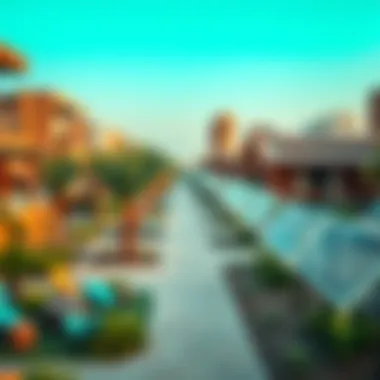
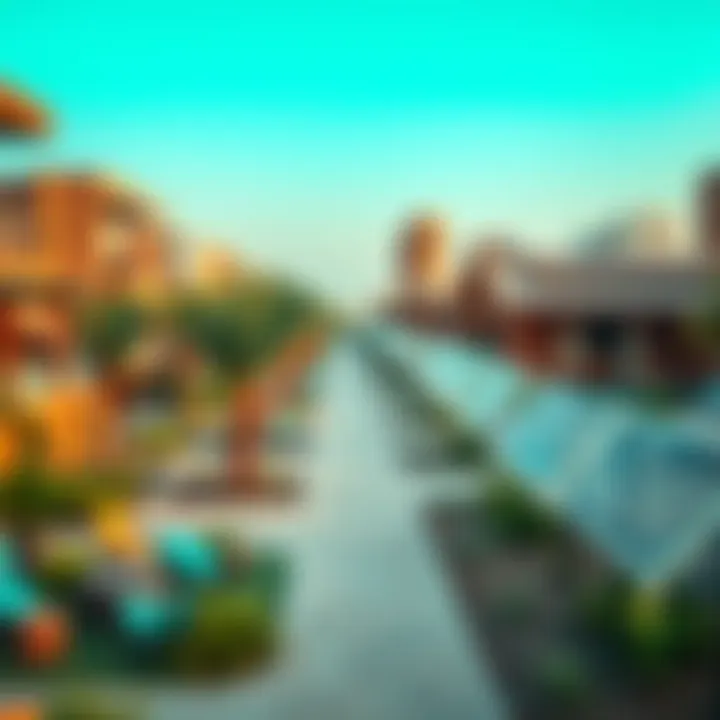
Looking ahead, these transport advancements are crucial not just for intra-city movement but also for attracting investors and residents who prioritize accessibility and modern infrastructure. A robust transport system can stimulate economic growth by enabling easy movement of goods, fostering convenience for residents, and making the city more appealing to international businesses.
For more insights on transportation in urban development, consider exploring resources like Wikipedia on Urban Transport.
Real Estate Market Dynamics
The real estate market in Dubai is a vital cog in the wheel of its economic machinery. Given its strategic positioning as a global metropolis, understanding the dynamics of this market is crucial for anyone looking to invest or reside in the city. The trajectory of the real estate sector not only reflects local economic health but also signals broader trends that can impact investors, homeowners, and developers alike.
One of the prime elements driving the real estate market is Dubai's Vision 2040, which aims to transform the urban landscape. With ambitious plans set in motion, there’s a burgeoning demand for residential properties that cater to the anticipated influx of expatriates and investors. A multifaceted approach to urban planning will undoubtedly reshape the market over the coming years, affirming Dubai’s status as a top-tier destination.
Projected Market Trends
Analyzing the projected market trends provides insight into the evolution of the real estate landscape. Some key trends to consider include:
- Increased Luxury Developments: There’s a noticeable shift towards high-end residential projects, catering to affluent buyers and investors. As Dubai maintains its allure as a luxury destination, developers are responding by bringing unique projects to life, characterized by lavish amenities and prime locations.
- Sustainability Movement: With a strong push towards environmentally friendly initiatives, developments that emphasize sustainability are increasingly attractive. This trend includes solar-powered buildings and energy-efficient designs, resonating with a populace that values ecological impacts alongside luxury.
- Suburban Expansion: Traditional downtown areas are seeing a migration trend. Families and individuals are looking for suburban options that offer better space and a sense of community without straying too far from urban conveniences. Developments like Dubai Hills Estate exemplify this shift, blending modern living with greenery and community facilities.
These trends signal a forthcoming era where investments in real estate are refined and tailored, aligned with the evolving demands of residents and investors.
Investment Opportunities in Dubai
The influx of various development projects creates a cornucopia of investment opportunities. Investors keen on Dubai's real estate sector can explore multiple avenues:
- Residential Properties: The growing population means sustained demand for housing, making residential apartments and villas prime targets for investment. Rental returns here have been favorable due to increasing demand, especially in newly developed neighborhoods.
- Commercial Real Estate: As businesses flock to the region, commercial properties, including office spaces and retail outlets, are gaining traction. An uptick in tourism and business activity is likely to ensure robust rental yields.
- Mixed-Use Developments: Fostering a community-focused approach, mixed-use developments create multifunctional environments where residential, commercial, and leisure spaces coexist. Investors seeking broader horizons can capitalize on these diversified spaces, mitigating risk while enhancing yields.
In summary, investors in Dubai's real estate market must align their strategies with emerging trends and innovative opportunities. This evolving landscape offers a wealth of potential that could translate into substantial foorture profits, particularly in conjunction with Dubai's strategic goals for 2040. The market dynamics at play here are anything but static, promising growth and adaptation as the city continues on its ambitious journey into the future.
"Investing in real estate is not just about bricks and mortar; it's about understanding the pulse of the market and embracing its dynamic nature."
For more detailed insights into real estate trends, consider exploring resources such as Wikipedia or relevant government publications from government websites.
Also, platforms like Reddit can offer community-driven insights on market sentiments.
Navigating these resources can equip you with the knowledge required to make informed decisions in Dubai's dynamic real estate market.
Community Living and Lifestyle Enhancements
Community living has become a vital aspect of urban environments, particularly as cities grow and evolve. In the context of Dubai's Vision 2040, enhancing community living is pivotal for creating a metropolis that balances modernity with cultural essence. This section explores various elements that contribute to enriched lifestyles, the benefits of community-centric design, and the considerations necessary for effective urban development.
Emerging Neighborhoods
Dubai's urban landscape is witnessing the emergence of innovative neighborhoods that are designed with a focus on community interaction and lifestyle improvements. The idea is to blend residential areas with recreational spaces, parks, and community hubs.
Some notable developments include:
- Al Quoz Creative Zone: A hub for artists and creatives, it features galleries, performance spaces, and studios, inviting residents to engage in collaborative and cultural activities.
- Dubai Creek Harbour: Integrating housing with waterfront views, this area emphasizes outdoor living, walkability, and civic engagement, making it appealing for families and individuals alike.
These emerging neighborhoods not only provide housing but also forge a sense of belonging among residents. They cater to diverse lifestyles, accommodating families, expatriates, and young professionals. The importance of communal areas in these neighborhoods cannot be overstated; they serve as vital spaces for social interaction, fostering relationships and enhancing personal well-being.
Lifestyle Trends and Local Culture
As Dubai progresses toward 2040, shifting lifestyle trends reflect the aspirations and identities of its residents. The fusion of traditional Emirati values with contemporary living creates a unique cultural narrative.
Key trends shaping community living include:
- Sustainability: Residents are increasingly seeking eco-friendly living options, driving demand for energy-efficient buildings and sustainable practices. This ties into broader environmental goals and the vision of a greener Dubai.
- Health and Wellness: The focus on well-being has surged, resulting in numerous fitness centers, wellness retreats, and public health initiatives. Community-oriented health programs encourage active living and enhance overall quality of life.
- Culinary Experience: An explosion of diverse food options reflects the multicultural makeup of Dubai. Food markets, local eateries, and community festivals celebrate the rich tapestry of world cuisines, encouraging social gatherings centered around culinary experiences.
Understanding these lifestyle trends not only plays a crucial role in attracting new residents but also ensures that the development strategies align with the community's evolving needs.
"Innovative neighborhoods linked by community spirit will not only provide a place to live but a sense of purpose and belonging that resonates across cultures."
Technological Integration and Smart City Initiatives
In today's rapidly evolving urban landscape, the interplay between technology and city planning is crucial. Dubai’s ambition of becoming a global icon by 2040 hinges on the integration of smart technologies that promise to elevate the quality of life for its residents and visitors alike. By marrying state-of-the-art technology with urban development, Dubai aims to streamline services, enhance efficiency, and foster a sustainable environment.
The essence of technological integration is not merely about incorporating cutting-edge gadgets; it’s about creating an ecosystem where technology seamlessly supports daily life. Residents will experience improvements in healthcare, education, and transportation—all pivotal aspects that contribute to a thriving metropolis. The objective is to ensure that as Dubai grows, it remains not just a city of steel and glass, but also one of innovation and livability.
AI and Big Data in Urban Planning
Artificial Intelligence and Big Data are the cornerstones of modern urban planning. These technologies allow for informed decision-making, predictive analysis, and tailored services that respond to the citizens' needs. By aggregating data from various sources—such as traffic patterns, energy usage, and social trends—Dubai can optimize urban strategies to address challenges proactively.
Imagine a scenario where traffic congestion is alleviated by AI algorithms that predict rush hours and adjust traffic signals accordingly. Smart waste management systems can alert authorities when bins are full, reducing the clutter on the streets. These applications of AI not only improve efficiency but also enhance the overall living experience in the city.
Moreover, residents can anticipate a future where city services are personalized. Apps that cater to individual preferences for public transport or communal spaces can be backed by the analysis of collective behavior, ultimately leading to a happier populace.
Cybersecurity Measures for Smart Cities
As Dubai advances toward a more interconnected infrastructure, cybersecurity cannot afford to take a backseat. Ensuring the integrity and safety of sensitive data is paramount. The rise of smart technology must be matched with robust cybersecurity frameworks to protect citizens' private information and maintain public trust.
City planners must prioritize multi-layered security protocols, which can include encryption, continuous monitoring, and quick incident response systems. The goal is to create an urban environment where technology facilitates daily life without compromising security. By doing so, the city will attract businesses and residents who place a premium on safety and reliability.
"In smart cities, technology should enhance human existence, not complicate it."
Furthermore, public awareness campaigns will play an integral role in educating inhabitants about best practices for personal cybersecurity in an increasingly digital world. As people become more informed, their confidence in the smart city initiatives grows, fostering a community that is both innovative and secure.
The future of Dubai rests on its ability to integrate technology thoughtfully and securely. As the city marches toward 2040, it is clear that the blend of smart solutions and active citizen engagement will be pivotal in crafting an unparalleled urban experience.
Environmental Sustainability Practices
As Dubai sets its sights on the significant shift toward becoming a global leader by 2040, the concept of environmental sustainability sits at the heart of this ambitious vision. This topic transcends mere trendiness, embedding itself into the very framework necessary for the longevity and resilience of the city. By enhancing urban living and promoting a more sustainable lifestyle, Dubai is not just reshaping its landscapes; it’s rethinking its relationship with nature, thus enhancing the experience for all its residents while making an impactful statement to the world.
Renewable Energy Adoption
A vital pillar of Dubai’s sustainability agenda is the adoption of renewable energy. The embrace of solar power has steadily risen, with projects like Mohammed bin Rashid Al Maktoum Solar Park symbolizing this transition. Not only does this reduce reliance on fossil fuels, but it also aligns with global efforts to curtail carbon emissions and combat climate change. As investors and developers scout for opportunities, this renewable energy shift signals a fertile ground for innovative energy solutions.
- Benefits of Solar Energy:
- Reduction in greenhouse gas emissions.
- Decreased energy costs for households and businesses.
- Job creation in the renewable energy sector.
Furthermore, by tapping into expansive solar technology, Dubai is positioning itself as a model for arid regions worldwide. As a bonus, the government offers incentives for both businesses and homeowners, fostering a win-win scenario where sustainability marries economic benefit.
Waste Management Innovations
Considering the rapid urban growth projected for Dubai, waste management innovations will play a crucial role in maintaining the delicate balance needed for a sustainable community. The Dubai Waste Management Strategy has set ambitious targets to recycle 75% of waste by 2023. Implementing smart waste bins that alert services when nearing full capacity showcases a proactive approach. The integration of IoT technology means inefficient collection cycles can become a relic of the past.
- Key Innovations Include:
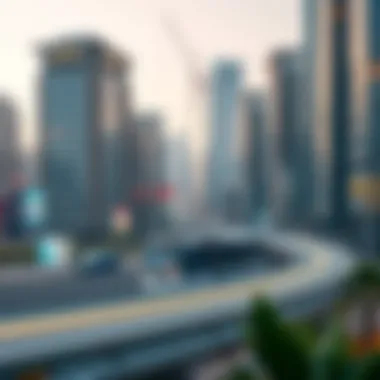
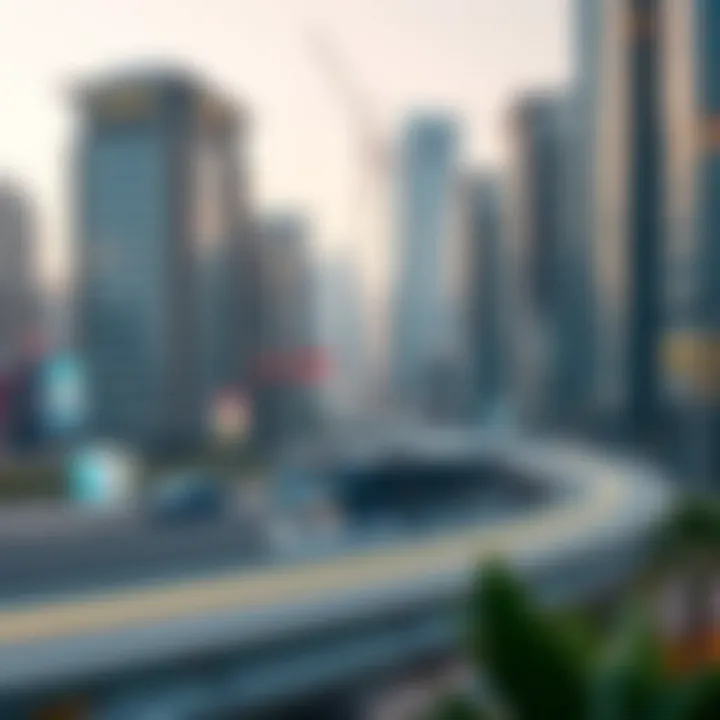
- Smart Waste Bins that monitor waste levels.
- Recycling Programs tailored to engage residents in sustainable practices.
- Organic Waste Converters to process food waste into compost rather than landfill filler.
This innovative approach does not just enhance efficiency; it also fosters a culture of recycling among residents, effectively engaging the community in sustainability efforts.
"In every sense, the future is now. Dubai’s commitment to embracing innovation and sustainability assures its place as a leader in responsible urban growth as it heads towards 2040."
Through these sustainability practices, Dubai isn’t merely preparing for its future; it’s crafting a legacy. Investors and homebuyers should take note: not only is there potential for financial gain, but participation in this thriving, ecological-conscious community offers a sense of belonging to something larger than just individual interests.
Economic Impacts of Vision
The economic landscape of Dubai is set for a transformational shift thanks to the Vision 2040 plan. Understanding these impacts is crucial not only for investors but also for residents, businesses, and government entities alike. The strategy revolves around diversifying the economy and minimizing reliance on volatile sectors, such as oil. Instead, there is a shift towards sectors like technology, tourism, and renewable energy. This thoughtful approach is aimed at fostering resilience and sustainability in the face of global economic changes.
Impact on Employment Opportunities
As Dubai embarks on this ambitious trajectory, employment opportunities are expected to see holistic growth. The Vision 2040 plan promotes a slew of initiatives aimed at creating jobs across various sectors. With an emphasis on tech innovations and sustainable practices, the job market will likely flourish in the following areas:
- Technology-related roles: As digital infrastructure expands, demand for software developers, data analysts, and cybersecurity experts is anticipated to rise.
- Tourism and hospitality: With an eye on tourism recovery, roles in this sector will not just proliferate; they’ll also evolve to include jobs focused on sustainability and eco-friendly practices.
- Green energy: A surge in the renewable energy sector indicates job creation in solar and wind energy installations, alongside research and development roles.
Moreover, as Dubai progresses with infrastructure projects and urban development, construction jobs will remain abundant, providing a fertile ground for skill development initiatives aimed at Emiratis and expatriates alike. As one key player in this field noted:
"An expanded workforce doesn’t just benefit the economy; it enriches the community by providing opportunities for professional growth and innovation."
Tourism and Global Economic Positioning
Tourism has long been a pillar of Dubai’s economy, but under Vision 2040, the position is set to be fortified even more. The plan aims to create a more diverse and appealing tourism framework, broadening the scope beyond luxury shopping and leisure. Here’s a closer look at what this means for Dubai’s economic standing:
- Cultural and eco-tourism: By developing cultural landmarks and promoting eco-tourism, Dubai is set to attract a wider audience. This move reflects a global trend where travelers increasingly seek experiences rather than consumerism.
- Increased connectivity: Enhancing transport infrastructure, such as the expansion of Dubai International Airport, is essential for boosting tourism. Improved air travel options will not only draw in more visitors but will also facilitate international trade.
- Event hosting: With Vision 2040, Dubai aims to establish itself as a global hub for events and exhibitions. Major conferences, trade shows, and sporting events will be strategically leveraged to foster tourism and business opportunities.
By articulating a clear economic direction through effective policies and community engagement, the “city of gold” is poised to continue its trajectory as a global metropolis throughout the 21st century.
Cultural Heritage and Future Aspirations
Cultural heritage serves as the backbone of any metropolis, especially for a rapidly evolving city like Dubai. As it marches towards the ambitious Vision 2040, preserving its rich tapestry of traditions and history becomes paramount. The unique blend of different cultures that have settled in this region brings benefits not only to the local identity but also to its global appeal. Simply put, the essence of a city can often be distilled into its cultural fabric, making it essential for fostering identity and community among its residents.
When we talk about the aspirations linked to cultural heritage, it’s about envisioning Dubai not just as a modern marvel but also as a custodian of its past. Future aspirations hinge upon weaving historical context into contemporary growth narratives. By prioritizing this balance, stakeholders can create an environment that acknowledges traditional values while embracing innovative practices.
"A city that forgets its roots can easily lose its way."
Preserving Traditions Amid Modernization
As Dubai gears up for 2040, the challenge lies in striking a harmonious balance between modernization and tradition. It’s almost like walking a tightrope—on one side, there’s the gleaming glass and steel of high-rise buildings, and on the other, the rich cultural heritage that has shaped the community for decades. It's essential to safeguard traditional crafts, local festivals, and architectural styles that define the essence of Dubai.
Benefits of Preservation
- Cultural Identity: Maintaining traditions fosters a sense of belonging among residents. This connection to the past nurtures community pride.
- Tourism: Tourists often seek authentic experiences. A city that celebrates its roots offers unique attractions that can't be found elsewhere.
- Education: Incorporating cultural heritage into educational frameworks helps younger generations appreciate their history, ensuring it is passed down.
To achieve effective preservation, initiatives like heritage festivals, cultural workshops, and museums can play significant roles. Projects aimed at restoring historical sites, such as the Al Fahidi Historical Neighborhood, are vital in retaining the old-world charm within the dynamic urban landscape.
Community Engagement in Cultural Projects
Community engagement is the key to ensuring that the cultural projects resonate with the locals. When residents take an active role in shaping their cultural landscape, it not only builds community spirit but also enhances the authenticity of cultural expressions.
One effective way to encourage engagement is through participatory art projects, where community members contribute creatively to murals or public installations that depict local stories. Such initiatives have the power to galvanize collective efforts across diverse backgrounds, allowing every voice to play a role in narrating the history of the city.
Additionally, organizing community forums where residents can share ideas about cultural initiatives promotes inclusivity. This creates a sense of ownership, making it more likely for the community to support and participate in cultural events.
- Collaborative Events: Events featuring local artists and performers can help diversify cultural representation.
- Educational Initiatives: Workshops aimed at teaching traditional crafts can engage younger audiences, connecting them to their heritage.
Challenges Ahead for Dubai
Navigating the future is no simple feat, especially for a city like Dubai that stands as a beacon of modernity amid rapid global changes. The aspirations embedded within the Vision 2040 framework are ambitious. However, acknowledging the potential challenges is crucial to manage expectations and foster resilience in the face of adversity. Those wishing to invest or settle in Dubai must also be cognizant of these critical roadblocks.
Economic Volatility and Investment Risks
In an ever-fluctuating global economic landscape, Dubai is not insulated from potential economic turbulence. Investors need to stay alert about the unpredictability that could stem from shifts in oil prices, trade tensions, or even geopolitical unrest in the region.
- Market Reactions: Fretting over economic instability can lead to knee-jerk reactions in the real estate market. Should there be even a whisper of economic downturn, property values might not hold as steady as one would hope, dampening investor optimism.
- Investment Caution: Investors eyeing Dubai must balance the potential for high returns against the inherent risks of economic volatility. A diversification strategy might mitigate losses but can also scatter focus. Hence, creating a sound financial strategy anchored in local economic conditions is vital.
Moreover, the quest for financial sustainability may see increased competition among investors. As developers and entrepreneurs rush to capitalize on Dubai's growth potential, there may be overcrowding in specific sectors. This can lead to oversupply, pushing prices down and making it harder for new investors to enter the market.
Ultimately, understanding these economic nuances can help develop a well-rounded investment approach. Those who can ride the waves of uncertainty, adjusting their tactics accordingly, are more likely to thrive.
Urban Migration Pressures
Dubai's inviting lifestyle is a double-edged sword. As people from around the world flock to this cosmopolitan hub, the pressure on infrastructure, housing, and community services intensifies.
- Housing Shortage: An influx of expatriates could amplify demand for housing, resulting in soaring property prices and affordable housing shortages. With accommodation becoming scarce, middle-income residents may find themselves priced out, leading to social tensions.
- Infrastructure Strain: High migration rates can place considerable strain on public services and infrastructure, from transportation systems to educational institutions. If these systems fail to adapt rapidly, it could lead to significant disruptions in daily life. If roads are clogged and schools overcrowded, it can sour the very image Dubai’s promoting.
"Cities that thrive do so by planning for growth while tempering its impact on their core."
This urban influx is also poised to challenge cultural integration, as newcomers bring diverse backgrounds, potentially leading to friction rather than harmony. Ensuring longstanding residents and newcomers can coalesce into a unified community is vital.
In summary, as exemplified through both economic volatility and urban migration pressures, the path ahead for Dubai requires keen foresight and strategic planning. Addressing these challenges head-on can facilitate sustainable growth, maintain social cohesion, and ultimately bolster Dubai's reputation as a dynamic global metropolis.
Stakeholder Participation and Governance
In the context of Dubai's ambitious plan for 2040, stakeholder participation and governance play a pivotal role. Effective governance structures combined with active stakeholder engagement are crucial in driving urban transformation and aligning various interests towards a common vision. The engaged facilitation of discussions among residents, investors, and policymakers not only strengthens public trust but also enhances the overall efficacy of developmental strategies.
Role of Private Sector in Development
The private sector holds a fundamental position in realizing Dubai's 2040 vision. Their involvement extends beyond mere investment; it encompasses an array of responsibilities that shape urban landscapes. From real estate projects to infrastructural advancements, effective collaboration between the government and private entities can lead to better resource allocation and innovative solutions.
- Financial Contributions: The infusion of capital from private investors can expedite projects significantly, helping to meet tight deadlines and ensuring that urban facilities are delivered on time.
- Innovation Drive: As the private sector is often at the forefront of technological advancements, their role in adopting and implementing innovative practices can result in more efficient and sustainable urban development. Think along the lines of energy-efficient buildings by companies like Emaar Properties, which are setting trends that align with environmental goals.
- Risk Management: The private sector can also share the risks associated with large-scale projects, thereby easing the financial burden on the public sector. This collaborative risk-sharing model promotes a healthier investment climate for all stakeholders.
Moreover, private enterprises engaged in this transformation can bring expertise to the table, suggesting improvements based on feedback and market trends. A healthy exchange of information ensures that developments are not only attractive but also functional and adaptive to a rapidly shifting urban nexus.
Public Consultations and Urban Policy Making
Public consultations represent a cornerstone in the governance framework for Dubai’s urban plans. Involving residents in the decision-making process ensures that developments align with the community's needs, thereby enhancing social equity and inclusivity. The practice of soliciting community feedback operates under several tenets.
- Transparency: Engaging the public fosters a sense of trust between the government and its citizens. When people see their feedback influencing decisions, they feel more connected and invested in the outcomes.
- Tailored Solutions: Consulting residents helps in crafting solutions that reflect the unique cultural and social dynamics of various neighborhoods. For instance, the Al Quoz Creative Zone was designed after extensive community input, ensuring it meets both the artistic aspirations and everyday needs of its citizens.
- Innovation through Diversity: Diverse opinions lead to diverse solutions. By allowing various stakeholders to voice their thoughts, policymakers can explore a broader array of ideas, resulting in more innovative approaches to urban challenges.

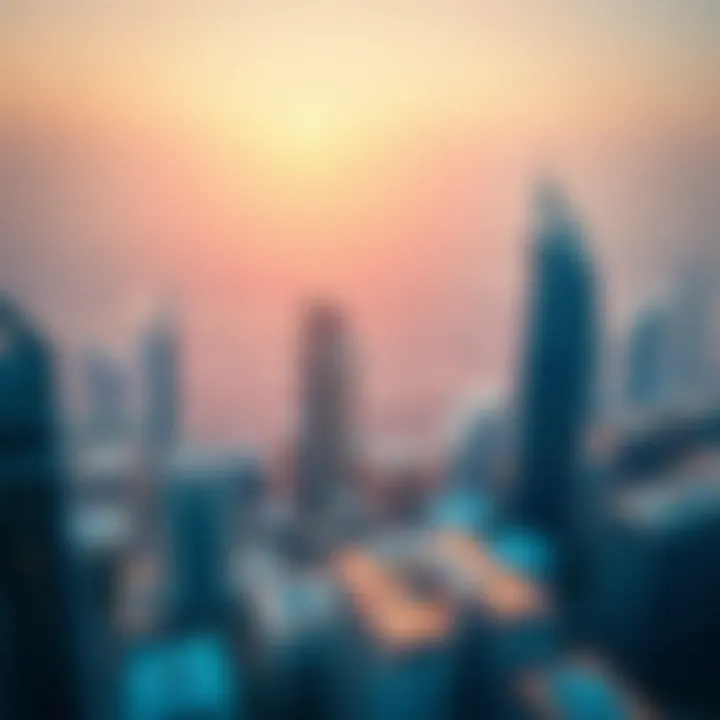
Public forums, workshops, and online surveys are all part of this process. Active participation is not just encouraged; it's essential for creating a sense of ownership among residents.
"A city is not just about buildings, but the life that thrives within them. Engaging the community can transform urban spaces into vibrant havens for all."
As Dubai marches towards 2040, the foundations laid through stakeholder participation and responsive governance structures will be the bedrock of its evolution as a global metropolis.
Monitoring Progress Towards Vision
In the journey toward achieving the ambitious goals set out in Dubai’s Vision 2040, monitoring progress is not just crucial; it’s the backbone of effective governance and development. Making sure each component of this grand vision stays on course demands an intricate touch and constant evaluation.
Monitoring provides a framework that makes it easier to assess whether the strategic initiatives are delivering the expected impacts on the economy, the environment, and the community at large. It ensures that all stakeholders—be it investors, policymakers, or residents—are aligned with the evolving objectives. Furthermore, establishing clear metrics for success allows for greater transparency, thereby building trust between the government and its citizens.
Additionally, accurate monitoring offers the ability to adapt quickly to changing circumstances. With technological advances continuously reshaping urban landscapes, adaptability becomes vital. By consistently checking in on these developments, Dubai can tweak its strategies as needed, ensuring alignment with its overall vision. The role of data is particularly significant; leveraging analytics fosters informed decision-making, allowing Dubai to stay ahead of the curve.
Benchmarking Development Outcomes
A key element in monitoring progress is the establishment of benchmarks to gauge development outcomes. Benchmarks serve as reference points, enabling the comparison of performance against both local and global standards. This practice ensures that Dubai remains competitive on an international scale.
- Performance Indicators: Implement specific metrics that assess economic growth, environmental sustainability, and social well-being. These indicators can include employment rates, energy consumption, and access to public services.
- International Standards: Look towards best practices from other successful metropolitan centers. Learning from what works elsewhere can be enlightening. Cities like Singapore or Barcelona, for instance, provide valuable insights into urban sustainability and social equity.
- Periodic Reviews: Schedule regular evaluations, which can pivot strategies when necessary and uncover areas for improvement. Engaging third-party experts can lend objectivity to the assessment process, ensuring outcomes aren't just favorable for the sake of public appearances.
Keeping an eye on these benchmarks cultivates a competitive spirit that drives continuous improvement among developers and other stakeholders. It encourages innovation and the implication of the best techniques in project execution.
Feedback Mechanisms and Reporting
Creating robust feedback mechanisms is imperative to the success of Dubai’s Vision 2040. Engaging with community voices ensures that the strategies being implemented resonate with the people they affect most. Failure to consider these insights may lead to misaligned priorities that hinder development.
- Surveys and Public Forums: Use surveys and community discussions to gauge the thoughts and feelings of residents. This opens a channel for dialogue, where citizens can express their hopes, concerns, and expectations regarding the ongoing transformations.
- Digital Platforms for Reporting: Implement online platforms that allow residents to report issues and provide feedback directly. For example, apps like CivicEngage can facilitate this dynamic.
- Transparency in Reporting: Publish regular reports detailing progress, setbacks, and upcoming plans. Transparency fosters accountability and invites continued public engagement, ensuring residents feel part of the journey toward 2040.
Involving citizens becomes a valuable asset, allowing government bodies to make decisions rooted in the lived experiences of those they serve.
In summary, monitoring progress towards Vision 2040 requires a multi-faceted approach encompassing the establishment of benchmarks, active feedback systems, and open communication channels. By embedding these practices into the developmental narrative, Dubai will not only spark confidence among stakeholders but also pave the way for a sustainable and enriching future.
Case Studies of Successful Urban Transformation
Examining case studies of successful urban transformation offers a clear lens through which to grasp the potential future for Dubai by 2040. These case studies serve not only as beacons of inspiration but also as repositories of practical insights that can guide planning and decision-making. As a city that has grown rapidly, Dubai's journey must consider global lessons to become more than a mere collection of remarkable skylines—transforming it into a flourishing and sustainable urban environment.
The significance of examining these cases cannot be overstated. There are multifaceted elements enveloping urban transformation, such as public spaces, transportation solutions, and environmental concerns. By dissecting the methodologies employed by other global cities, Dubai can hyper-focus its vision towards effective engagement, collaboration, and overall urban effectiveness while avoiding pitfalls faced by those past examples.
Comparative Analysis with Global Cities
By looking at places like Singapore and Barcelona, Dubai can glean insights into innovative urban practices that redefine city living. Singapore, for one, has prioritized green architecture above all else. Its vertical gardens and urban parks are not just aesthetic additions; they reflect a robust vision to integrate nature amid concrete. This model teaches Dubai about capitalizing on its climate to promote green living. Moreover, Barcelona’s emphasis on community-focused urban planning embodies the need for inclusive spaces that foster social integration.
- Singapore: Promotes ecological sustainability through elaborate park connectors and rooftop gardens.
- Barcelona: Excels in creating public spaces that prioritize pedestrian traffic and community interaction through initiatives like the "superblock".
These cities have effectively leveraged technology and cultural heritage to redefine their urban landscapes, advancing both livability and resilience. Photogenic waterfalls juxtaposed against glass towers or dedicated cycle paths offer visual variance that can delight residents and tourists alike.
Lessons from Global Examples
Learnings from other urban areas can facilitate a tailored approach for Dubai's Vision 2040. Consider the error-prevention wisdom drawn from cities that faced negative feedback due to insufficient local engagement. Many cities faced backlash for gentrification without prior community consultations. Engaging local stakeholders can ensure that development aligns both with the city's vision and the residents' needs.
Moreover, consider the lessons gleaned from cities with well-conceived public transport systems. Cities like Tokyo and Amsterdam underscore the importance of integrating diverse transport modalities that ease congestion and reduce carbon footprints. These cities have effectively employed smart technology not only for efficient transit but for promoting lower emissions—a capability that Dubai could harness in configuring its sprawling transport systems.
"Informed urban development is not merely about infrastructure; it’s about creating spaces where community and culture can thrive together with environmental stewardship."
In Dubai, the intricate balance between innovating and preserving cultural aesthetics can pave a path towards integrating technology with traditional values. The goal is not merely to evolve but to evolve wisely. Engaging deeply with global precedents sets a solid foundation for what Dubai can construct—an urban metamorphosis that considers the human experience first and foremost.
Key Takeaways:
- Public Engagement: Urban transformation should not overlook local voices.
- Sustainable Development: Designing cities with a green focus can enhance living standards.
- Integrated Transport Solutions: Implementing multi-modal transport can ease urban congestion.
As Dubai presses toward 2040, utilizing these lessons creates a roadmap rich with potential, one that is carefully curated from examples round the globe.
Perspectives on the Future of Dubai
When it comes to envisioning Dubai’s future, understanding the perspectives of various stakeholders becomes crucial. These perspectives shape the strategic decisions that underpin urban development and help in creating a sustainable city. The insights from innovators and thought leaders, as well as the anticipated global trends, offer a lens into how Dubai aims to position itself by the year 2040. For investors, homebuyers, agents, and developers, aligning with these perspectives can not only ensure profitable ventures but also contribute to the shared vision of a thriving metropolis.
Innovators and Thought Leaders' Insights
Innovators and thought leaders play a key role in shaping Dubai’s trajectory toward 2040. They are often the ones testing the waters and steering the ship into uncharted territories. For example, visionary architects are rethinking how we inhabit urban spaces in Dubai. They are advocating for designs that blend futuristic aesthetics with mental well-being, emphasizing natural light, open spaces, and integrating nature into the concrete landscape.
A notable perspective comes from Dr. Khaled Al Hossani, an urban planner in Dubai, who argues for a mixed-use development approach. "The future of urban living lies in creating spaces that serve multiple needs—work, play, and live—all within one area," he states. This perspective is not just about construction; it encompasses social interaction and quality of life, which are both at the heart of Dubai’s Vision 2040.
Many companies are also investing heavily in technology as part of their innovative approaches. For instance, businesses in the tech sector are encouraging collaborations to foster an environment of creative problem-solving. This is particularly evident in Dubai's commitment to becoming a leading smart city.
Anticipated Global Trends Affecting Dubai
As Dubai strives to craft its future, it must take heed of global trends that have far-reaching implications. One such trend is the increasing emphasis on sustainability. With climate change being a pressing international concern, renewable energy sources like solar power are no longer only a choice but a necessity. Investors need to pay attention to this shift as it affects property values and the desirability of certain locations.
Furthermore, the rise of telecommuting and remote work, accelerated by the global pandemic, has triggered changes in urban planning. Cities worldwide are adapting to a new kind of urban dweller that seeks space, nature, and a balanced lifestyle. Dubai's response to this should be constructing homes that cater to these evolving preferences.
"Adaptability is the name of the game. Those who fail to evolve with the trends are bound to face challenges." -- Jane Mahmood, a real estate strategist in Dubai.
Finally, demographic shifts, notably among expatriates and millennial populations, influence how Dubai designs its neighborhoods and cultural centers. To cater to these groups, there is a growing demand for affordable housing, vibrant community spaces, and access to lifestyle amenities. Investors and developers must react to these indicators and ensure the supply aligns with this heightened demand.
In summary, perspectives on the future of Dubai reveal that it is not just about building structures but crafting a holistic urban experience that prioritizes innovation, sustainability, and community engagement. For stakeholders, aligning with the views of thought leaders and being cognizant of global trends is essential for navigating the opportunities and challenges ahead.
End: The Road Ahead for Dubai
As we look towards the future of Dubai in 2040, it becomes clear that this metropolis is not just sculpting its skyline but is redefining the very essence of urban living. The ongoing transformation captures a wide spectrum of initiatives that blend sustainability, innovation, and economic growth, making it imperative to understand the implications of these developments.
The significance of discussing the road ahead cannot be understated. The evolving landscape is not merely a canvas for architects and urban planners; it holds a treasure trove of opportunities for investors and residents alike. The strategies laid out in the Vision 2040 document signal a robust approach to tackling challenges, while simultaneously embracing possibilities that boost community engagement and quality of life.
Final Thoughts on Sustainability and Growth
One cannot delve into the future of Dubai without emphasizing the criticality of sustainability in urban planning. Integrating eco-friendly practices is not just a trend; it is a core tenet of the Vision 2040 framework. By focusing on sustainable energy sources, such as solar and wind, Dubai aims to reduce its carbon footprint and combat climate change. This initiative germinates various benefits:
- Improved Air Quality: Cleaner energy leads to cleaner air, enhancing overall health for residents.
- Biodiversity Conservation: Through improved green spaces, the local ecosystem fosters diversity, essential for maintaining balanced habitats.
- Long-term Cost Savings: Investment in renewable resources often results in more affordable utility bills.
Furthermore, the interplay of sustainability with growth stimulates economic vibrancy. Innovative businesses focusing on green technologies will likely sprout, providing new job avenues and attracting talent.
Implications for Residents and Investors
Residents and investors both stand at the precipice of significant change as the Vision 2040 unfolds. The fused efforts between urban planners, policymakers, and community leaders signal a bright future. For residents, the anticipated enhancements in public transportation, the integration of smart technology, and expanded cultural amenities result in a heightened living experience. Additionally, neighborhoods are being designed with social interactions in mind, fostering a sense of belonging.
For investors, the focus on Dubai as a global hub opens multiple channels for lucrative investment. Key areas to consider include:
- Real Estate Development: The influx of people into transformed neighborhoods can drive property values up, making it a wise investment.
- Start-up Ecosystem: With increasing emphasis on technology and sustainability, there's a promising landscape for tech and eco-friendly startups.
- Tourism Sector: As Dubai further establishes itself as a cultural and leisure hotspot, real estate geared towards tourism is projected to flourish.
In essence, the road ahead for Dubai is filled with potential. A commitment to merging tradition with modernity, whereas attracting global attention, leads to a promising horizon. As more initiatives take flight, the allure of this stunning city will only intensify, creating a rich tapestry of opportunities for all stakeholders.



